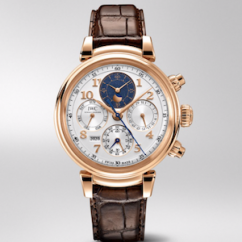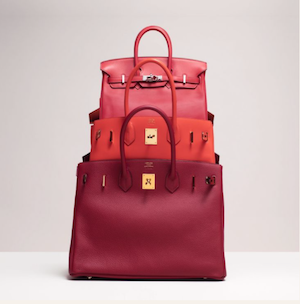Articles and News
Fifth Annual State Of Luxury Report Portends Major Shift In Market January 05, 2021 (0 comments)

Stevens, PA—2021 will be a year of transition for the luxury market after the reset brought on by the Covid-19 pandemic, says a new report jointly authored by Unity Marketing, Luxury Daily, and The Home Trust International. The luxury market is entering a new era of conscientious luxury, as opposed to conspicuous luxury which has been the driving force in the luxury market for the last 50 years or more, and luxury companies will be forced to adapt or be left behind. Image: An IWC DaVinci Perpetual Calendar Chronograph watch is pricey but not showy.
But 2021 also will bring significant opportunities, says the fifth annual State of Luxury report. Key points from the 100-page report (see the table of contents here):
- Conscientious, not conspicuous, consumption. Although “new luxury” has been a buzzword for years, most luxury companies have taken baby steps to adapt. The global pandemic, however, is going to require stepping it up.
- COVID-19 pandemic will bring needed change. More than one-fourth (28%) of luxury insiders surveyed for the report saw a silver lining coming out of it and believe it will bring needed change to the luxury industry.
- Luxury revenues are down less than 10%. In the early days of the pandemic, luxury sales plunged and executives in the industry were predicting a disastrous year. But it turned out to be not nearly as bad as initially feared: thereport shows the average change in luxury companies’ revenues was -9% for goods and -8% for services and experiences in 2020—and not all companies were down. (82% of luxury jewelers, in fact, were up for the year.)
- Luxury consumers’ shifting shopping behavior is a key challenge – The changing ways consumers shop for luxury (i.e. digital) is causing the greatest challenge for luxury insiders this year. Luxury companies are also facing challenges from consumers who are less willing to trade up to luxury.
- Younger consumers don’t define luxury in the same way previous generations of consumers did, making it harder for established brands to make a meaningful connection with them.
- Continued rates of infection combined with a global downturn in the economycontinue to be a primary concern for the luxury insiders polled for the report.
- Advertising spending will be cut in 2021. 30% of companies surveyed for the report plan to reduce their advertising and marketing expenditures in 2021.
But marketing experts in the jewelry industry advise against that. When the pandemic first hit and nobody knew what the future would hold, Ellen Fruchtman, president of Toledo, OH-based Fruchtman Marketing, urged jewelers to stay the course and not cut any of their marketing plans. As it turned out, she was right. Although the report shows the overall luxury market saw revenue declines, luxury jewelers had a banner year last year, besting even their record-setting totals of 2019.
Related: Season Totals Astound Jewelers
Opportunities in 2021. On the flip side of business challenges is opportunity, and 2021 will present plenty of both, which are detailed in the report.
While the luxury industry has talked for years about “New Luxury,” it has continued to cling to old luxury ideas and business practices. Instead, luxury companies must welcome the era of conscientious, rather than conspicuous, consumption.
“This health crisis and the way we are reacting to it is a symptom of underlying weaknesses,” says Dr. Martina Olbertova, founder of Meaning.Global consultancy and an expert on brand meaning, in the report. “It is a wake-up call to brands [and] can serve as a great catalyst to transition to the new luxury paradigm faster than they probably would under normal circumstances.”
She warns luxury brands not to expect business to return to normal after the crisis abates. “Luxury brands need to be thinking about future-proofing their businesses in ways that go beyond catering to different markets. They need to think about serving people’s essential needs that revolve around what is scarce and luxurious.”
Ultimately, she says, the symbolic value of luxury isn’t going to change. “Many of these luxury brands have been around for hundreds of years. There is always going to be demand for something that is handcrafted, premium quality, and of lasting value.” Ultimately, she says, this may cause luxury brands to return to their roots and true legacy value, probing more deeply into what their brands mean, vs. pumping out high-priced, mass-produced logo products to feed consumers’ demand for visible symbols of success.

Hermès Birkin bags not only retain their value, but often appreciate on the secondhand market.
“This is a time to create and strengthen brand perceptions, which ultimately create value. That’s all anchored in meaning,” she says in the report.
The opportunity in 2021 is to create a new vision of the luxury market that builds on its great past, rather than simply reacting to the shifting tides of consumer trends, concludes the report. Although the luxury market is likely to shrink in 2021, that’s actually a good thing.
“We have too much product and it’s not necessary. People need less but want better.” While it’s important to adapt to the new shopping channels consumers are flocking to, just investing more money in tech is not the be-all and end-all solution.
“We need to start at ground zero and reinvent the industry proactively rather than simply reacting to current conditions. It requires listening actively and creatively to the voice of the consumer.”
To purchase a full copy of the report in an easy-to-digest Powerpoint format that details both survey findings and key takeaways, click here.







